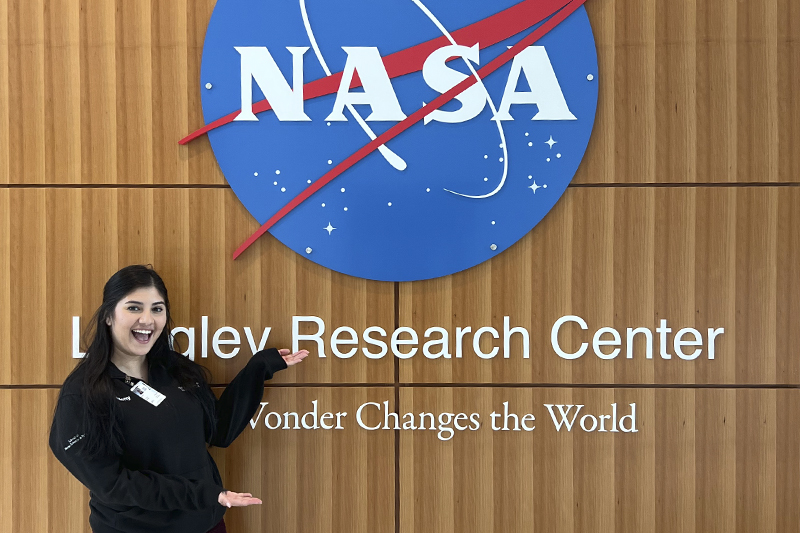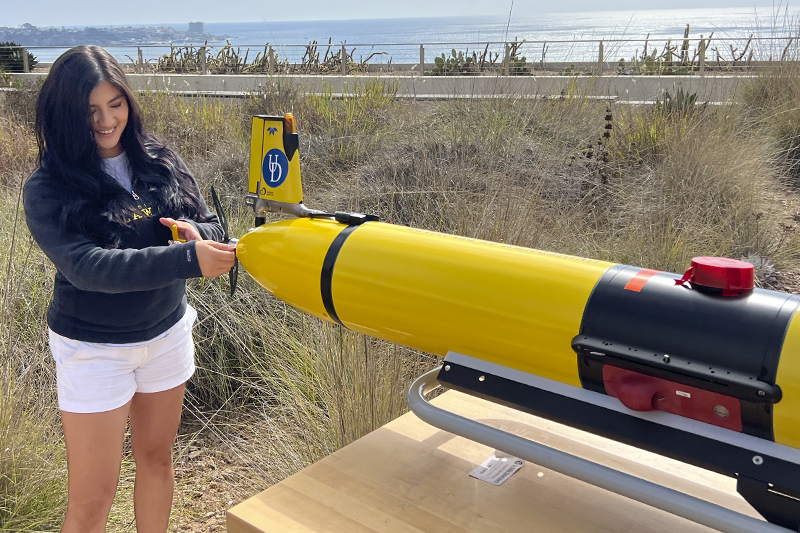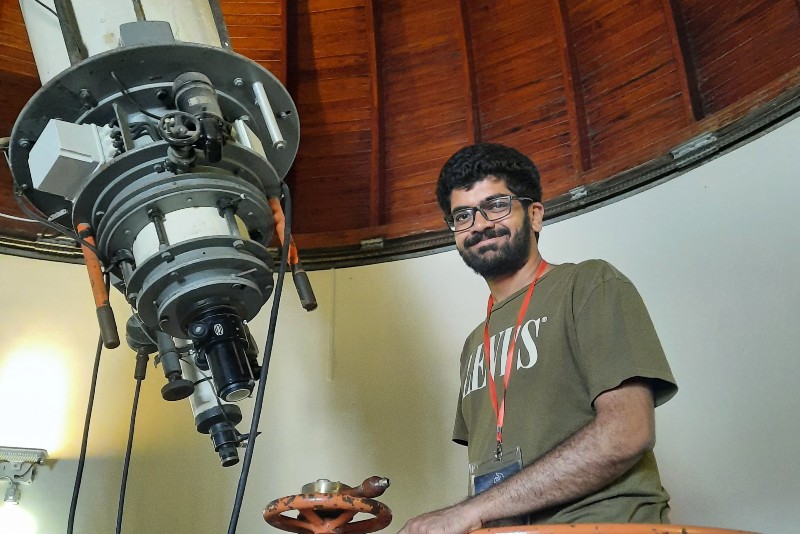


NASA’s next generation of scientists
Photos courtesy of Yuleny Gomez Rodriguez and Siddharth Chaini October 07, 2025
Two UD doctoral students receive NASA FINESST awards to study the sea and the stars
From the sea to the stars, two University of Delaware doctoral students — one studying the ocean and the other the cosmos — are charting new frontiers as part of NASA’s next generation of scientists.
Yuleny Gomez Rodriguez, who is studying oceanography, and Siddharth Chaini, who is studying astrophysics, each received a NASA FINESST (Future Investigators in NASA Earth and Space Science and Technology) award, a prestigious research fellowship that provides funding to graduate students for innovative, self-designed research projects aligned with NASA's goals in Earth and space science. The highly competitive fellowship offers up to $50,000 annually for up to three years to support tuition, travel and research expenses and aims to support the next generation of NASA scientists and engineers.
Studying the daily commute beneath the waves
Every day at dusk, marine organisms travel to the surface of the water in order to feed. At dawn, they travel back down to deeper waters in order to avoid predators. This process, known as diel vertical migration, plays an important role in the transportation of carbon from the surface of the ocean down to deeper ocean layers, as the marine organisms making the journey respire and excrete carbon during their daily journey.
The traditional way of studying diel vertical migration is through acoustic technology. Instruments such as echosounders can emit sound pulses and measure the return echoes, which are affected by the presence and size of organisms. Rodriguez, an oceanography doctoral student in the College of Earth, Ocean and Environment, will use her NASA FINESST award to research whether this daily migration can be tracked optically as well.
Using a glider equipped with both acoustic and optic sensors, Rodriguez started collecting data for the first time in Santa Barbara in the fall of 2024. From that initial deployment, she was able to gather a large dataset of diel vertical migration.
The goal of the research is to determine how much carbon these organisms are moving up and down in the water column every day.
“It’s a big part of the biological carbon pump, but we're not really sure who the key players are, what they’re contributing and how much they’re contributing,” Rodriguez said. “With optic sensors, you can start to get at those questions because you're able to make proxies between the particles, the chlorophyll and the carbon.”
As the glider dives, it records nonstop. The researchers have collected a full month of these dives and can see the particles in the water at specific points in time.
“Over time, we put all of these together into a picture and you see how, at the surface, there are a lot of particles, but as you go deeper you see fewer particles,” Rodriguez said. “Then, during the days and nights, there are regions where we see features pop out where it looks like there's an increase of particles.”

Rodriguez said these features look like big blobs of high backscatter, which could mean many things, like sinking aggregates of larger phytoplankton cells or zooplankton swarms in the water.
“It’s interesting because these features only show up at night, and they disappear during the day,” Rodriguez said.
From these images, Rodriguez can begin to see which processes might be shaping these features.
Rodriguez is also looking at data compiled by a LiDAR sensor on NASA’s ER-2 High Altitude Airborne Science Craft that was gathered over the same channel where she deployed the glider to compare the two datasets.
“We're trying to see if we are detecting the same things in the water that they are with these two different technologies,” she said. “They mainly use the sensor to look at things atmospherically, but they're interested to see if their laser can penetrate the water deep enough to see what's under the surface. It was nice to have a glider in the water in the same region looking at the same things to see if they're detecting the same structures as the ER-2.”
Rodriguez is interested to see if this LiDAR technology is something that can be used on a broader scale, using remote sensing to study the diel vertical migration not just regionally but globally, allowing researchers to cover vastly bigger swaths of the ocean and not be restricted to only the sections of water where they deploy gliders.
As an undergraduate student majoring in biology and chemistry at the University of North Carolina at Charlotte, Rodgriguez planned to attend medical school. To bolster her medical school application, she decided to pursue research, and the only available opportunity was in a marine ecology lab. The experience with Paola Lopez Duarte, now an associate professor at Portland State University, changed her career trajectory.
Rodriguez spent that summer collecting fiddler crabs to see how they synchronize their spawning times with the lunar cycles. Intrigued by the fact that these tiny creatures were somehow influenced by the lunar cycle, she decided to pivot and see what other opportunities awaited her in the field of marine science. It also allowed her to have the opportunity to one day pass on the mentorship that she received from Duarte.
“Without her, I wouldn’t have gotten to this point because I didn’t grow up by the ocean, and I didn’t grow up with a lot of STEM mentors around me,” said Rodriguez, who is the first member of her family to get a higher education degree. “Having her as a role model as an oceanographer opened my eyes to this possibility of, ‘I can see myself in her shoes. I can see myself doing what she's doing.’ That was very instrumental to me pivoting from medical school to graduate school. That is something I consider to be very important, and I want to continue that because there's so many younger girls who are going to be looking up to me as well and saying, ‘OK, well if she did it then I can do it, too.’”
Using machine learning to study the skies
Chaini, an astrophysics doctoral student, is quick to tell you about Annie Jump Cannon and Jocelyn Bell Burnell, pioneers in the history of astronomy. Using his NASA FINESST grant, he hopes to join them as a trailblazer in the field.
Chaini, working with astrophysics professor Federica Bianco in the College of Arts and Sciences, studies time domain astronomy, examining the patterns of light curves of the sky, looking for changes in brightness or color. Variations in the curves can indicate when a specific event, like the explosion of a star, happened, or even the existence of previously unknown objects.

“We have a data-driven approach to our science, where you keep collecting data and then analyze it,” Chaini said. “This allows you to take past data and see things like where a supernova blew up.”
But there are gaps in the kind of existing data that time domain astronomists use to study the skies, because it comes from sources that were designed to meet different scientific goals and take different variables into account. For example, ground-based observatories may not collect as much data as space-based telescopes because it may be clear one night and rainy the next.
To fill in the gaps, Chaini will use machine learning to create a common feature set from existing data from the ground-based Zwicky Transient Facility (ZFT) in California and NASA’s space-based Transiting Exoplanet Survey Satellite (TESS), which was launched in 2018. While the surveys are very different, Chaini said they complement each other.
Creating this machine learning tool is only the first step, Chaini said. The next is what he calls the “discovery” part of the project, where he uses the tool to look for patterns in the data. Those patterns hold the key to the “seeing” changes happening in the universe and can point to previously undiscovered objects.
Chaini noted that the work is more important and timely as new projects like the new ground-based Vera C. Rubin Observatory Legacy Survey of Space and Time, and the launch in 2027 of NASA’s Nancy Grace Roman Space Telescope will provide mountains of new data about our universe.
Physics isn’t the only field that can benefit from the new machine learning tools, Chaini said. Disciplines like earth sciences and health sciences can apply and modify them to their specific data.
By the end of his two-year grant Chaini hopes to have found a new object in the night sky.
“A lot of the discoveries that have pushed astronomy have been serendipitous, where no one was really looking for a specific pattern in data, but a graduate student found a squiggle in the data and was able to follow it up and suddenly it’s a new class of objects,” he said, smiling. “There has to be something there because we have never seen the universe in this way before, and I want to help find it.”
Contact Us
Have a UDaily story idea?
Contact us at ocm@udel.edu
Members of the press
Contact us at mediarelations@udel.edu or visit the Media Relations website

